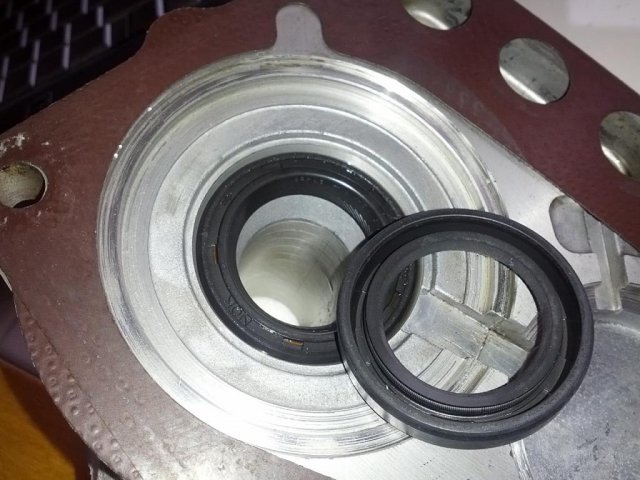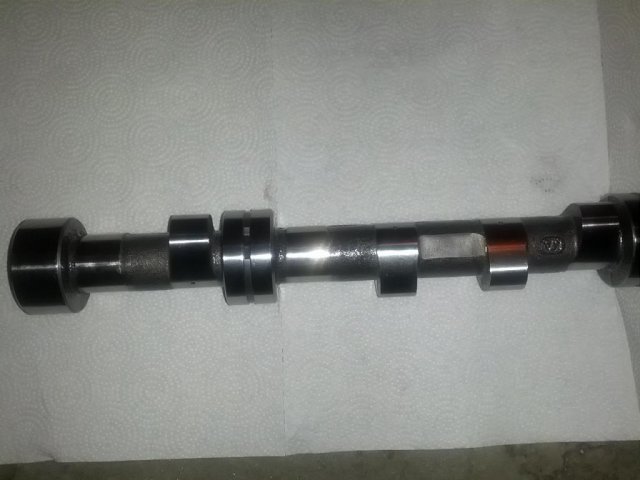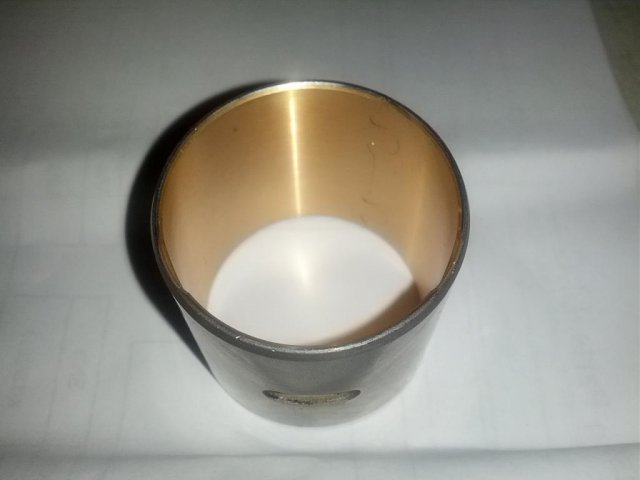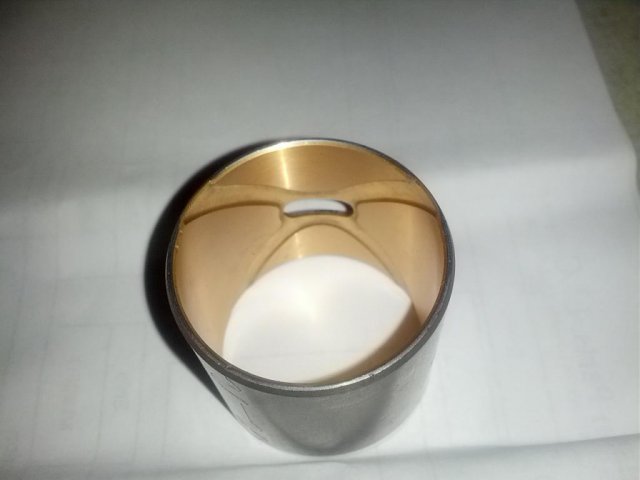-
Posts
453 -
Joined
-
Last visited
-
Days Won
3
Content Type
Profiles
Forums
Blogs
Events
Gallery
Downloads
Store
Posts posted by inline6
-
-
The installed seal is backwards.
Rule of thumb is to install the seal so that increasing the pressure on the seal will make it seal tighter...as you've got it installed, the seal will be pushed away from the shaft as the pressure against the seal increases.
Flip the seal and it will be correct.
Oh! Totally makes sense that the seal will be pushed away from the shaft as any pressure pushes on it. Wow. Learned something today.
-
Working on transmission a bit while my engine is back at the engine builder. It appears I have another transmission leakage issue. What I thought was oil leaking out the of the back of the engine (I thought past the rear main side seals) is almost certainly transmission fluid. This means I have leaks coming from both the back and now, the front transmission seals. The thought occurred to me... I am currently running Redline MT90 transmission fluid. This stuff certainly seems "thinner" than what I've typically run in the past. Is it too thin?
One other issue is I may have the front transmission seal installed backwards. I tried looking at the 280ZX workshop manual to determine, but I wasn't able to tell conclusively. I see 2 shiny rings around the mainshaft where the seal rides... so this is confirming to me that the part of the seal that touches the mainshaft is in a different spot than some time prior.
Here is a pic showing the front seal installed with a new front seal just sitting off to the side - reversed from the one installed.
Not sure why it would be leaking though as it looks to me like the seal is still riding on a spot on the mainshaft that looks like it would work. That said, I still think I need to pull it out and flip it around. Can anyone confirm?
[edit] - yeah... it is in backwards. Clearly, the spring side of the seal isn't supposed to be facing the outside of the transmission where dirt and stuff can get to it. I am still not convinced that flipping it around will stop the leak though as the lip of the seal appears to be riding squarely on the mainshaft surface that it should be - it is just offset to near the edge of that surface. So, I wonder if the MT-90 is too "thin"?
-
Tiny bit of good news for me in such a long time with this car - the pump I got yesterday is the real LD pump. Same ground off markings and stick on Aisin label. The impeller was about 1/16th" smaller than 3".
-
This is where drilling holes and using plugs at overhaul time comes into it's own. I remember drilling and plugging Vega heads apprenticing in the machine shop... later, checking oil flows and cleaning passages was a snap!
During the full rebuild, the press fit plugs were all removed and the oil galleries cleaned METICULOUSLY. Engine has to come out to have the freeze plug spikes (I forget what they are called) installed anyway. I guess I have no choice but to remove the head. Incidently, oil temp has a major impact on flow as seen by some vids another HybridZer sent me. My videos were with 10W30 redline at like 65 degrees.
-
Still seems like you have too much restriction between the main head supply passage and the oil pump.
Since there's a restriction at the head/block interface there should really be another measurement point in the head to show if the cam is getting proper oil pressure. Pressure is generated by restriction to flow. If you could measure there you'd probably get a low number. Did you get a pressure reading from the car's gauge, showing what it was in the main gallery, or just have 120 psi in the tank?
And did you plumb in to the center port to the where the oil filter mounts to pressurize and feed the oil? Not really clear. Seems like 120 psi would blow oil all over the place, even cold, if it was the main gallery at 120.
I took the oil pressure sender out and used that hole in the mail gallery for the tank supply location. I did not measure psi while operating it. I have a regulated air supply from my compressor that I set at 120 psi when I filled the tank. I also have a 60 psi air gauge. Just before doing the second video, I measured the pressure in the tank, and judged it to be about 80 psi by the amount the needle was past 60 psi.
During the 20 minute run with fresh cam and freshly re-ground rockers I saw 70 psi coming from the oil pressure gauge - this being read from the oil pressure sender which was in the stock (and same) location in the block. I have no idea what oil pressure the head is seeing. I might be able to remove the npt fitting at the back of the cam (I had one installed there instead of a press fit plug) and rig some kind of pressure gauge there to see what I've got for oil pressure inside the cam.
Would that be helpful? Does anyone have a good number for me to compare to? I can regulate the tank pressure to 70 psi or whatever and then get a number for pressure at the cam...
-
Finally got moved and had a chance to hook up a pressure kit. I put a quart or so into the small tank and pressurized the tank to 120 psi. Didn't take the best video footage on the first one. Second one was much better. With the second video, I had an estimated 80 psi left in the tank. The spray bar is clearly useless. Take a look:
Video 1:
http://www.youtube.com/watch?v=rXAo8S7Wetc
Video 2:
http://www.youtube.com/watch?v=sFZM4P1Dfqo
So... Is that enough flow?
-
I purchased the Aisin WPN-079 and received the gas pump, the model info on the box only lists LD engined Nissans.
I contacted them to ask if they had the correct pump, or if they could measure any remaining pumps to confirm the correct size before I bought another one. The reply was 'no and we don't have a pump for your Nissan'. Strange thing was when asked what car I have I quoted all models, years and LD28 engine separately as printed on the Aisin box

Some got the right one from them it seems from the activity in the last few weeks. We'll see if the one I get is right or wrong. That they wouldn't or couldn't measure means that can't confirm the statement that they don't have the right pump for you. I mean, how do they know for sure if they didn't look at or measure them?
-
Well I went and did a search for WPN079 on RockAuto and I get a Valeo water pump. So no idea what it's for, because it's not listed under Diesel Maxima. Never mind, looks like it's for a 280ZX and some other Nissan vehicles
I just did a search for WPN-079 on RA's site and it brought up two listings - first the valeo and second an application of 81 Datsun 810 and 82-83 Maxima only - look at the second listing, not the first one. Manufacturer listed is AISIN. Part numbers listed match the box that is pictured about page 3 (I think by Dreco) in this thread - a confirmed correct pump. I only bought one - there are three left.
I'll let people know what comes, though by then, I doubt there will be any left.
-
Aaah! I have been moving for the last week or so and haven't been watching the forums.

-
You have a big problem somewhere that has nothing to do with internal vs. External oiling of cam. Even a small amount of oil pressure up top should prevent this damage. Either a blockage or path that allows oil to escape. Does the cam have the ends plugged?
I had to pay $100 just to have the rear of the new cam drilled/tapped for an NPT plug which I did before assembly this second time around. Front is sealed by the cam gear bolt of course.
I'm in the middle of moving this weekend, so I can't do much with the car at the moment. Rocker arms have been removed but the cam is still in the engine. I am on the lookout for the pressure outfit my builder is sending me.
Garrett
-
-
Damn dude - that sucks bad.
I'm not for the dual oil system , but to exclusively blame that as the issue- I'm not sure about that. Like I said before, with what you have been dealing with I would have kept it simple and decided on one oiling system. Did you verify visually oil was getting to every lobe before starting? By now I would have can opened a valve cover to watch in real time.
No, I have not visually checked to see if oil is getting to every lobe. I was/am scared to death to turn it over at cranking speed to test that... And I don't think turning the oil pump shaft at power drill speed is sufficiently fast enough to observe (accurately) oil flow from the spray bar... My engine builder is sending me his pressurizing outfit, so I can hook it up to the block and check oil flow without cranking.
Ya know... another thing... my valve springs are running 56 lbs pressure at installed height, so it's not like I have this excessive valve spring load I am dealing with.
Within a few seconds of starting the oil pressure gauge showed just north of 70 psi (yes, I know, this is at the block main passage) and stayed pretty much right there for the full 20 minutes (maybe dropped 2-4 psi as oil got warm). Ran it at 2500 RPM only!
For F sake.
-
-
Fired up the engine tonight with the new cam in it. I ran it at 2500 RPM for 20 minutes and shut it off.
This time around, I have a chill cast Estas blank, ground with the same master Integral Cams used to make the first cam, but there has been no nitride treatment. I used redline assembly lube on the lobes and main journals. And instead of using Mobil 1, I am using Redline racing oil. Was a $100 for two gallons delivered, and the comp pan took it all. Of course, since the engine has run before, and carbs are adjusted, etc. I got initial fire up after two very brief turns of the starter.
I confirmed with my engine builder that the oil restrictor supplying oil to my cylinder head remains unmodified. I didn't know that the hole should be enlarged for my application. Not doing that until the head comes off for freshening. I have the stock spray bar for now in addition to the internal oiling of the cam. I'd like to get either the billet one from LarryZ or maybe the Rebello one.
Fingers crossed that I don't have a problem with the cam or rockers this time.
-
Even stock the spray bar may not adequately lube lobes at idle, hot. It's kinda why they went to the drilled cams.
But at speed, both systems keep things cool up top. Either one will lube the lobes, but that extra oil blowing over everything takes more heat out of the components, like the valve springs, and even the head.
They both may not go to the lobes at hot idle...but the drilled lobes are sufficient for that. It's higher rpms where the spray bar starts being beneficial for the reasons mentioned. The decreased surface tension of synthetic oil should help wet upper end components better and also aid in heat removal. Heat kills springs!
So Tony, what is the scoop on running internally oiled cams along in conjunction with the stock sway bar - one has to drill the restrictor in the supply from the block to that head or not? I have seen you comment in another thread (Post 15) that this should be done when running both an internally oiled cam with the stock external spray bar.
If there isn't a definitive word, then how about a recommendation? Or a guess? My engine's bottom end is fresh with correct bearing clearances. I want to say 2.5 thou, but I'm being lazy by not looking at my build specs right now.
By the way, I've been trying to get my hands on the billet spray bar from LarryRacer240Z, but it has been half a year and still none have been manufactured by his supplier. Maybe for my 50th birthday (in six years) i'll get one.
-
Was reading the forums about running both internal oiling and the stock cam spray bar and I see that there is discussion about opening up the restrictor in the top of the block to .100" as well as running the turbo oil pump. I am running the pump, but I think the restrictor is stock sized. Could that be part of my problem? I am just now installing a replacement cam... and don't want to fire it up only to experience the same problem.
Other things I will be changing is, I am running Redline Racing oil instead of Mobile One. This was per the recommendation of Megacycle Cams.
Garrett
-
Duragg makes a good point. Check the trans vent at the top of the tailshaft. If it is blocked the heat expansion of the air will casue oil leaks. Also, check the bore for the oil seal, perhaps if has a gouge in it from changing the seal that is causing the leak.
Thanks for the input. Very good sucking sound coming from the top of the trans when I drained the oil to remove the rear extension. Oil came out very smoothly. So, air vent is open. Inspected the periphery of the oil seal machined cut-out. A couple of very minor nicks, but otherwise looks good. Must be something else.
-
I took the rear housing off of the trans and pressed the old bushing out. Upon close examination, it isn't bad at all. In fact, the ID on it is tighter than the new one. I used some 2500 grit sandpaper to clean it up a tad. It actually fits more tightly on the yoke sleeve than the new ones. Since it is longer, and obviously in ok condition, I put it back in instead of the new one.
Now, I am back to square one. I don't know why I have this rear oil seal leak.
 Was it my imagination that I saw lots of deflection when pushing on the yoke of the driveshaft while it was in the car? The bushing obviously limits deflection... The stock driveshaft yoke sleeve measures 1.475 OD. The Inland Impire Driveline yoke sleeve measures 1.476 OD. The new bushing measures 1.482 ID... The stock bushing is probably a few thousandths smaller ID...
Was it my imagination that I saw lots of deflection when pushing on the yoke of the driveshaft while it was in the car? The bushing obviously limits deflection... The stock driveshaft yoke sleeve measures 1.475 OD. The Inland Impire Driveline yoke sleeve measures 1.476 OD. The new bushing measures 1.482 ID... The stock bushing is probably a few thousandths smaller ID... I dunno.
I dunno.The main shift rod, that I replaced the o-ring and little oil seal on before, is perfectly dry. Absolutely no leakage there.
I took the rear oil seal from the spare transmission and slid it onto the yoke sleeve. It actually fits a bit tighter than the relatively new oil seal that was on the trans in the car. So, I'll throw that one away and buy another new one from Nissan. But, I've replaced that with a new OEM one before... and still had the leak. I suspect another new one won't change anything.
Pretty stumped. I hate fluid leaks.
-
That's a 4-cylinder bushing, and it's a little shorter but as long as you line up the oiling hole, it's no big deal. That's what I used.
The 6-cylinder FS5W71C has a slightly longer bushing, apparently, but I haven't found a place to get them other than Nissan. They are available, but I don't have the part number off the top of my head.
Hmmm. Interesting. Yeah, I looked all over the internet and couldn't find a part number listing for a FS5W71B. But, I wish I hadn't paid $14 for mine (I actually bought two), before I knew about the $4 ones.

G
-
The new cam came in.
Oil holes are in interesting locations... Many are in close proximity to the center of the base circle. Some are closer to the opening ramp. And 2 and 11 are just after the closing ramp. Sheesh. Can no one get that right?
Was going to work on installing it tonight, but unfortunately there is no rear oil galley plug. Going to have to take it to a machine shop to get it drilled and tapped for a 3/8" NPT. There are a couple of Datsun shops around this area (north Atlanta), right?
Garrett
-
Here is the one I got.
It appears to be the right OD and ID, but it is 1/8th of an inch shorter than stock. And it only has cutouts/flutes on one side of it. Xnke, were the one's you sourced like mine? Also, stock length or a little shorter?
And, mine was $14 plus shipping... instead of what... $3 from Cobra?
Garrett
-
They can be had from transmission shops, I got a few of them from Cobra Transmission in Florida. They are available, and are a soft sleeve bushing that can and should be replaced when worn out.
Is this the part you are speaking of? The picture is different than the factory... No cut outs or flutes for transmission oil to lube the yoke. Were the ones you got like the part pictured, and if so, how have they worked for you?
-
More likely the 2 seals inside the shifter thing. They leak down and look exactly like the rear seal.
There is one o-ring and one Lip seal.
You have to pull the extension, remove the shifter mechanism, bang out the rear cap, pull out the long rod and then push out and replace the lip seal.
Then bang / stake the rear cover which I gooped also.
Then the external o-ring.
Put it all back together (Again) and you should be fine.
My experience...
Oh, right. I actually thought at one point along the way that either or both of those were the issue. When I started looking into the problem seriously (a few of months ago now) I did replace those first (the seal and the o-ring on the shift shaft) but I still have the leak. The shifter shaft and top of tail housing is dry - in this case, the fluid is coming out of the rear seal location for sure. The deflection of the driveshaft which appears to visibly allow a separation of the yoke tube to the oil seal lip is my primary indicator at this point.
Garrett
-
I found this today.
http://www.manualtransmissionpart.com/FS5W71-Bushings-Washers.html
I placed an order for one, I'll report back when it comes in whether it is the right part.























High RPM shifting dynamics
in Drivetrain
Posted
Man, that is a bummer. I've been hoping that this would take care of it once and for all. I hate the 1st to 2nd crunch. Any chance that you don't have the timing spot on? If that is right, then what is left to look at? Could the dog teeth be worn a bit too much on second gear?